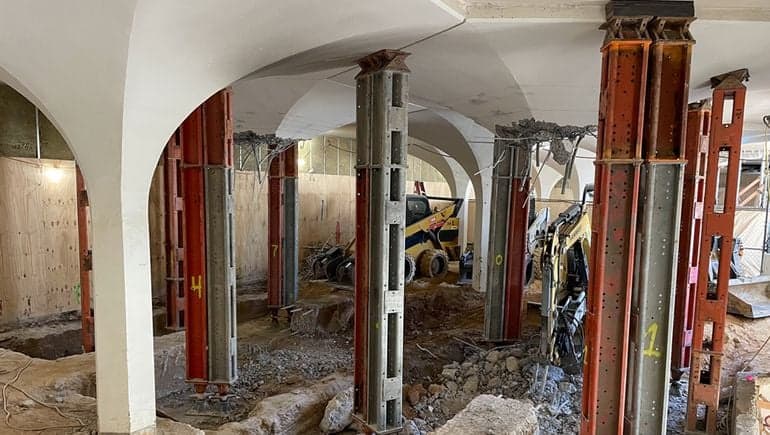Many buildings within seismic zones are not built to withstand the impacts of earthquakes. Legislators in seismic regions across the U.S. have updated building codes and regulations to better handle seismic events for new construction and have put legislation in place to bring older buildings into compliance.
PCL Construction has been a leader in the seismic retrofit field for more than two decades, working on nearly 100 seismic projects across California and the Pacific Northwest.
The Challenges Behind Seismic Retrofitting
There is more risk and unforeseen circumstances behind seismic retrofit of older buildings, but a lot of that can be avoided through early investigative work during design.
The contractor often discovers asbestos and lead-based paint once they start accessing beams and concrete. Abatement poses challenges, especially in operating buildings.
“Safety is the number one priority for PCL,” says Sam Wen, a construction manager with PCL’s California Buildings office. “It’s imperative to make sure the abatement area is isolated properly to ensure workers and building users are not exposed. Communication is also critical so there are no surprises.”
Additionally, identifying mechanical, electrical and plumbing lines during design and incorporating that scope duration and cost upfront helps ensure the project is successfully on schedule and budget.
Avoiding Occupant Shake-Ups
PCL is well-versed in keeping an occupied building functioning during a seismic retrofit, such as the UCLA Center for Health Sciences (CHS). CHS is the second largest U.S. public building (next to the Pentagon) and conducts $2 billion in research annually. PCL has constructed $250 million dollars of seismic work in the building while maintaining building operations. Crews had to navigate the installation of shear walls at a CHS laboratory amidst a nine-month experiment. Halting the experiment to complete seismic work was not an option so the team worked with the University to create a solution. Jeffery Hoese, general superintendent, explains that the team installed a beam above the laboratory to support the weight of seven stories of installed shear walls. Once the experiment was complete, PCL came back to install the remaining shear wall in the laboratory.
“I am proud to work with a group of innovative solution providers day in and day out,” says Hoese. “This project was the epitome of a truly collaborative effort to overcome challenges, minimize impacts to users and ultimately provide a safer structure for years to come.”
One Size Doesn’t Fit All: Complex Seismic Techniques
Most seismic retrofit techniques share the same goal, according to Larry Karlson, a structural engineer with PCL’s Integrated Construction Services team. Seismic retrofitting either aims to boost a building’s ability to resist lateral forces (which often cause structural collapse), lower the lateral forces a building will experience during an earthquake or both. Seismic retrofit techniques vary widely in their approach and complexity.
- Fiber-reinforced polymer (FRP): Material used to wrap columns or shear walls to prevent cracks or breakage. This technique is the least invasive and provides structural strength.
- Viscous Dampers: Acts as a shock absorber, similar to those on your car. Dampers minimize lateral movement and stress on the structure and allow buildings to move separately in the event of an earthquake.
- Seismic bolting: Bolt two buildings together at a seismic joint using large bolts (approximately four to five feet long and two inches in diameter) to make the buildings more ridged and heavier so they can move together during seismic events.
- Internal and external concrete shear walls or steel bracing: Offer backup support to keep a wall from collapsing on itself under pressure.
Involving the Contractor Early
It is critical the owner works with the contractor as early as possible to allow for extensive investigative work. This allows for more certainty in schedule and cost because unforeseen aspects and risks have been accounted for.
Contractors can’t just rely on as-built drawings; they need time to investigate what is behind walls and under ceilings and floors. Then, they can provide feedback to architects and engineers so drawings can be adjusted.
“For many of our seismic projects, we advise the owner to allow us to spend a small amount of money upfront for investigative work on the building during the design process,” says Nicholas Rigali, PCL superintendent for seismic retrofit project, York Hall at the University of California San Diego. “This helps provide price and schedule certainty.”
Involving the contractor early on allows for collaboration with the client around finding innovative solutions to project challenges, such as utility shutdowns. Water and power shutoffs need to be coordinated closely with the client to minimize impacts on users.
PCL’s team of experts share a sense of passion and pride when it comes to their work. “It’s more than just updating buildings, it’s about saving lives,” says Wen.


